Correct posture for meditation:
- Elongate the Spine
Having established this firm foundation it is important to lift yourself up through your spine. Traditional analogies say that your spine should be like an arrow or a stack of coins, one on top of the other. It is as if a rod could go through the top of your head and down through your bottom. You want to feel uplifted when you sit down to meditate. 
- Resting Your Hands
The simplest thing to do with your hands is to rest them on your lap. You can drop your hands at your sides and pick them up at the elbow then drop them palms down on your thighs. This is a natural axis point on which to rest them, providing better support for your upright spine. Sitting with your palms down tends to relax the flow of energy throughout your body.
Alternatively, you can place your right hand on top of your left with your thumbs very lightly touching, resting them on your lap at your navel. This creates more heat and energy in the body, which can be useful if you are feeling sleepy. Symbolically, the left hand represents wisdom and the right compassion. In this gesture, you are bringing the two together.
- Fourth Point of Posture: Relaxing the Shoulders
Let the muscles in your shoulder and back relax. Your shoulders can be pushed slightly back. This establishes a strong back while opening up the front body. There is a touch of vulnerability in this point of posture as we expose our tender heart.
- Tucking in the Chin
Slightly tuck in your chin. You don’t want to go so far that you are looking directly down at your lap but you don’t want your head held so far upwards that it may tire you out.
- Resting the Gaze
Relax your gaze two to four feet ahead of you on the ground in an unfocused manner. Don’t pick out patterns in the rug in front of you. Just maintain a loose gaze. Rest your eyes. Sometimes people do not understand why they should open their eyes during meditation. For one, we are always gazing at our world—why should we treat our meditation practice as a time to hide from our life? It is instead a time to look directly at who we are. So our eyes can be open as a gesture toward that intention. On a practical level, you are less likely to fall asleep with your eyes open.
If you are unable to meditate with the eyes open you can close them. It is important to make a conscious decision before beginning to meditate on which you will do or you will fidget back and forth the entire meditation session between those options. It has been said that closed eye meditation leads to more thoughts, daydreams, and distractions. But if this is not the case for you, you can certainly meditate with your eyes closed.
If you take the time to establish your meditation posture correctly, you will find it is much easier to rest your mind and connect with the object of your meditation. When you go through these seven points you will enter your practice feeling relaxed yet uplifted.